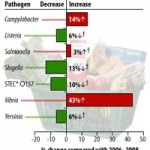
Rates of foodborne illnesses stay the same: report
By Food in Canada magazine staff
Food Safety Food Trends campylobacter foodborne illnesses listeria salmonellaThe CDC’s latest report on the rates of foodborne illnesses in the U.S. finds that they have not changed significantly in recent years
Atlanta, Ga. – The Centers for Disease Control (CDC) has released the results of its latest annual food safety report card.
The report calculates whether foodborne illnesses are increasing and, if so, how fast, says Occupational Health & Safety Online (OHS Online).
The report has found that 2012 rates of infection from two germs spread commonly through food have increased significantly from the 2006-2008 baseline period, but most others have not changed. The data come from CDC’s Foodborne Diseases Active Surveillance Network (FoodNet) report.
Infections from campylobacter, which is linked to foods including poultry, raw milk, and produce, climbed to 14 per cent in 2012 compared to 2006-2008.
Vibrio infections as a whole were up 43 per cent when compared with the rates observed in 2006-2008, but vibrio vulnificus, the most severe strain, has not increased. Foodborne vibrio infections are most often associated with eating raw shellfish, says, OHS Online.
Rates of a dangerous type of E. coli, Shiga toxin-producing E. coli (STEC) O157, went back up to 1.12 per 100,000 population in 2012 after declining to 0.95 per 100,000 population in 2010.
The CDC says data from FoodNet, which monitors the incidence and quantifies laboratory confirmed cases of foodborne illnesses caused by nine pathogens, provide the best measure of trends in foodborne disease in the U.S.
The report covers 19,531 infections, says MedScape.com, that required 4,563 hospitalizations, with 68 deaths. Included infections must have been diagnosed in a microbiological laboratory that isolates the pathogen.
Overall, the 2012 FoodNet data showed a lack of recent progress in reducing foodborne infections and highlight the need for improved prevention.
The graph shows the changes in incidence of laboratory-confirmed bacterial infections in the U.S. in 2012 compared to the baseline period 2006–2008.
 Figure 1
Figure 1
(Link to larger image of graph.)
• The incidences of laboratory-confirmed Listeria, Salmonella, Shiga toxin-producing Escherichia coli (STEC) O157, and Yersinia infection did not change significantly in 2012 compared with 2006–2008.
• Campylobacter was the second most common infection reported in FoodNet (14.3 cases reported per 100,000 population). Incidence of infection was 14% higher in 2012 compared with 2006–2008.
– Exposures related to Campylobacter infection include consumption of undercooked poultry, raw milk, produce, untreated water, and contact with young animals.
• Vibrio infections are rare (0.41 cases reported per 100,000 population). Incidence of Vibrio infection was 43% higher in 2012 compared with 2006–2008.
– Some types of Vibrio infections are often serious.
– Many Vibrio infections are acquired by eating raw oysters. These infections are most common during warmer months when waters naturally contain more Vibrio organisms.
– Infections can be prevented by thoroughly cooking oysters and by not exposing wounds to bodies of warm seawater.
• As a group, the incidence of infection with six key pathogens transmitted commonly through food (Campylobacter, Listeria, Salmonella, E. coli O157, Vibrio, and Yersinia) was not significantly different in 2012 than in 2006–2008.
Long-term trends
The CDC also compared the 2012 results with the first three years of FoodNet surveillance (1996–1998), which shows some clear changes:
• The incidence of infections caused by Campylobacter, Listeria, STEC O157, Shigella, and Yersinia has declined, mostly in the first years.
• The overall incidence of Salmonella was unchanged, but the incidence of some types of Salmonella have increased while others have decreased.
• The incidence of Vibrio infection is now 116% higher.
• The overall incidence of infection with six key foodborne pathogens (Campylobacter, Listeria, Salmonella, STEC O157, Vibrio, and Yersinia) was 22% lower.
Recent efforts and next steps
Most foodborne illnesses can be prevented, says the CDC. Some progress has been made in decreasing contamination of some foods and reducing illness caused by some pathogens.
Recent efforts to reduce contamination of food and prevent these illnesses include:
• Establishment in 2011 of performance standards for Campylobacter contamination of whole broiler chickens in processing plants.
• Approval of more stringent time and temperature controls for oysters after harvest to prevent Vibrio vulnificus infections.
• The Food Safety Modernization Act External Web Site Icon of 2011: It gives FDA additional authority to regulate food facilities, establish standards for safe produce, recall contaminated foods, oversee imported foods, and which requires improvements in surveillance and response to outbreaks. It calls on CDC to strengthen surveillance and outbreak response.
More can be done, adds the CDC. Determining where to target prevention efforts that will reduce foodborne infections requires continued collection of information to understand sources of infection, implementation of measures known to reduce food contamination, and development of new measures.
Click here for a larger view of main image: Food Safety Progress Report for 2012
Print this page